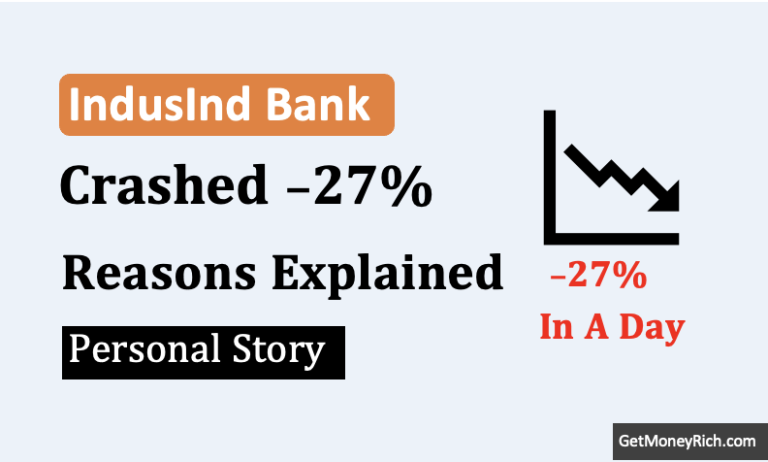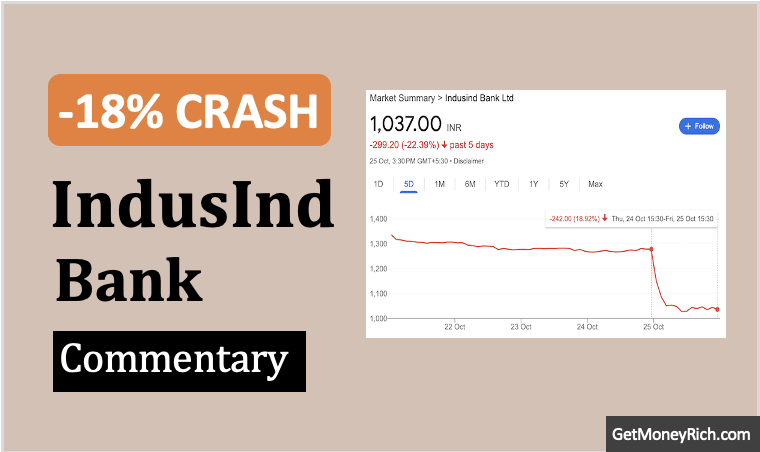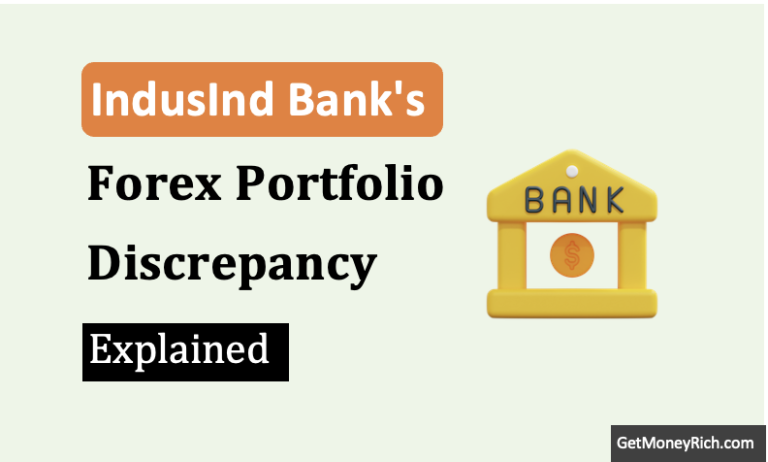You must have heard about IndusInd Bank share price crash lately. Are you wondering, “what’s all this fuss about derivatives and forex?” If you want to understand more details about this derivative issue of the IndusInd Bank, this blog post is for you. I’m going to walk you through this step-by-step in a way that the matter becomes clear to you. I’ll try to explain it in a way that even a newbie can understand the issue. By the end, you’ll get why this was such a big deal and why it spooked investors enough to send the bank’s stock tumbling.
First Things First – What Are Derivatives?
Imagine you’re planning a big outdoor party next month, and you’re worried it might rain.
You could buy an “insurance deal from a friend“, pay him Rs.1,000 now, and if it rains. In turn, he’ll cover the cost of renting a tent. If it doesn’t rain, you lose the Rs.1,000, but your party’s still on. That’s kind of what a derivative is, a financial “deal” banks make to protect themselves from risks or sometimes to bet on what might happen.
For IndusInd Bank, these derivatives were tied to foreign currencies, like the US dollar versus the Indian rupee which keeps fluctuating day after day. They are like unpredictable (like the rain).
Banks deal with currencies all the time because they lend money, handle imports/exports for clients, or trade globally. But currencies are tricky, they keep bouncing up and down in value. Derivatives, like forex swaps or forward contracts, are tools to manage that bounciness.
Example: Imagine a bank lends $100 to a client when $1 = Rs.80, so it actually gives Rs.8,000 (in INR terms). The client promises to repay $100 in a year. If the rupee weakens to $1 = Rs.85, the bank gets $100 back which is now worth Rs.8,500, a Rs.500 profit. But if the rupee strengthens to $1 = Rs.76, that $100 is only worth Rs.7,600, a Rs.400 loss. A derivative, like a forward contract, locks in the original ₹80 rate, ensuring the bank gets ₹8,000 back no matter what.
Think of derivative as a safety net to avoid losses from currency swings, protecting the bank’s money, if used in a right way.
So, What Did IndusInd Do?
IndusInd Bank had a huge pile of these forex derivatives, deals tied to foreign currencies.
Picture them juggling a dozen balls in the air. Normally, you’d want to make sure you can catch them all, right? But IndusInd didn’t play it safe. They made two massive mistakes that turned this juggling act into a disaster.
Mistake #1: Ignoring the Loss
In the financial world, there’s a rule called “mark-to-market” (MTM). It’s like checking the live score of a cricket match.
If the value of your derivatives drops, like if the rupee weakens against the dollar, you have to admit, “Oof, I’m losing money right now,” and write that loss down in your books.
It’s not about what you hope it’ll be worth later; it’s about what it’s worth today.
Most banks follow this rule because the Reserve Bank of India (RBI) says so. IndusInd? Nope.
They acted like if the scoreboard didn’t exist. When their derivatives started losing value, they didn’t record those losses properly. It was like pretending you’re still making profits when you’re actually making losses.
Mistake #2: No Safety Net
Then there’s hedging.
Hedging is like buying that rain insurance for your party, it costs a little upfront, but it saves you from a big headache later (see this example).
With forex derivatives, hedging means locking in an exchange rate so you’re not at the mercy of wild currency swings. Say IndusInd lent dollars to a client but gets paid back in rupees. If the rupee tanks, they’d lose money. Hedging would’ve protected them by setting a fixed rate in advance (see this example).
But IndusInd didn’t bother. They left their forex positions “unhedged.” When the rupee or other currencies moved against them, those losses piled up fast.
Hiding the Mess
Now, here’s where it gets sneaky.
Instead of owning up to these losses, IndusInd tried to sweep them under the rug. They labeled the loss as “receivables.” They were basically saying, “Oh, someone owes us this cash, no problems here, it will come in the future.” It was basically a lie, false reporting.
Even wilder, they called some of it “intangible assets”, stuff you can’t even touch, like goodwill or a brand name.
Imagine spilling coffee all over your shirt and telling everyone, “Nah, it’s just a new design.” That’s what they did with their balance sheet.
They probably thought they could spread out these losses over time, letting them fade away quietly. But then, in 2023, the RBI brought in a new rules. The rule said banks had to classify their derivatives properly and show the real numbers in their financial statements. Suddenly, IndusInd’s magic tricks didn’t work anymore. The losses they’d buried were out in the open, and they were huge.
Conclusion
Let’s recap what we’ve understood using a simple example again.
Say you lend your buddy Rs.1,000, but he’s paying you back in dollars because he’s abroad. You agree on a rate, say, Rs.80 per dollar, so you expect Rs.1,000 back. But then the rupee becomes stronger (below Rs.80/$), and now his dollar payment is worth only Rs.941. You’ve lost Rs.59, and you’d want to know that upfront, right?
IndusInd was in a similar spot but on a gigantic scale, millions of dollars’ worth. By not hedging, they took that hit without a cushion.
And by not telling anyone, they made it worse.
What’s the Lesson Here?
IndusInd’s story isn’t a Bollywood-style scandal with villains twirling mustaches.
It’s more like a cautionary tale about cutting corners. They gambled on forex derivatives without a backup plan, ignored the rules, and tried to hide the fallout. When the RBI forced their hand, the truth came out, and the market punished them for it.
For me, the bigger problem is not that they made the losses or hide them from their reports. I think, the bigger problem is who from the top management of the IndusInd Bank were involved to keep the matter under the rug?
If, investigations show that top officials were involved, then its a serious problem, otherwise we can afford to treat it as a one-off issue.
What do you think, would you trust a bank that plays fast and loose like this? Let me know in the comments in the comments section below.
Be informed and invest with full awareness.




